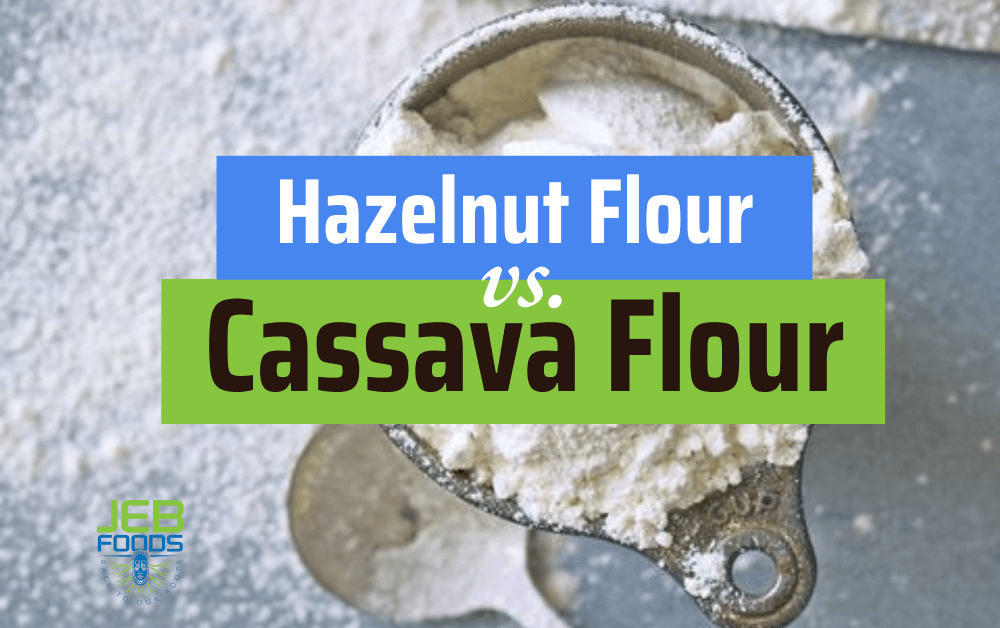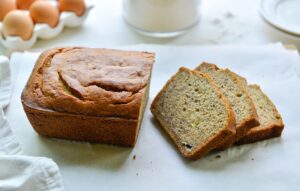I will compare Cassava Flour Vs. Hazelnut Flour to see which one is superior, why it is a favored option, and under what baking conditions.
Flour is an important element in baking, and as a baker, the growing awareness of the importance of gluten sensitivity and gut health has necessitated the adoption of a gluten-free lifestyle.
Gluten-free flour has become a household word as a wheat-free flour substitute.
In this essay, I will focus on the similarities, differences, benefits, and drawbacks of cassava flour and hazelnut flour.
A Brief Overview Of Cassava Flour vs Hazelnut Flour
Table of Contents
ToggleCassava flour is a gluten-free, grain-free, and nut-free flour with the same flavor and texture as wheat flour. No other flour comes close to wheat flour in texture, flavor, and character without the bother of modifying your recipe!
This thick, starchy, and nutritious root vegetable has become a versatile gluten-free, grain-free, nut-free alternative to wheat when dried and processed into flour.
It is not the same as tapioca starch – but both are made from cassava, containing more carbohydrates (resistant starch) and healthy dietary fiber than wheat flour.
The taste of the fine powder is earthy, and the adhesive properties are convincing.
Read the full cassava flour overview here
What is a hazelnut Flour
Also known as hazelnut meal, it is made from whole raw hazelnuts. It’s a Paleo-friendly, grain-free nut flour and gluten-free, low-carb. It tastes sweet and has a nutty flavor.
There are two types of hazelnut flour; the hazelnut residues are used after the nut oil production for the de-oiled variant. These remnants – the press cake – are finely ground.
As a result, partially de-oiled / de-oiled hazelnut flour has a higher protein content, more fiber, significantly less fat than ground hazelnuts, and fewer calories.
So if you want to save calories, but not on the taste, you should rely on the partially de-oiled variant. In addition, the de-oiled variant usually has a more delicate texture than the ground hazelnuts.
Similarities Between Cassava Flour And Hazelnut Flour
- Both flours have a few similarities, let’s take a look at some of the basics;
- They are both paleo-friendly.
- They are both gluten-free and grain-free.
- Both are high in dietary fiber.
Difference between Hazelnut flour and cassava flour
Cassava flour may be used in many of your favorite recipes in place of wheat flour, making it a flexible flour for individuals with allergies or on a strict diet.
If you would love to know which is preferred for baking between cassava flour vs Coconut flour, I compared them here.
Health Benefits Of Hazelnut As It Compares With Cassava Flour
Folic acid, manganese, proteins, fiber, and omega-3 fatty acids are all found in hazelnut flour, whereas cassava flour is high in dietary fiber and vitamin C.
Hazelnuts are high in phenolic compounds, which have been proven to boost antioxidant defenses in the body. To obtain the maximum concentration of antioxidants, consume hazelnuts whole and unroasted.
Hazelnuts may boost the oxidative capability and lower blood lipid levels, lowering the risk of heart disease. They also appear to aid in the normalization of blood pressure.
Although additional study is needed, hazelnuts’ high content of antioxidant chemicals, vitamin E, and manganese may help reduce the incidence of some malignancies.
Because of their high quantities of good fats, hazelnuts may aid in preventing and reducing inflammation. Other elements, however, are equally essential.
Hazelnuts include several chemicals that may aid with blood sugar regulation. However, the data is inadequate, and their potential advantages require more investigation.
Hazelnuts are available whole, sliced, ground, uncooked, or roasted. They are often used as a snack or as an ingredient in baked products and other meals. It’s better to eat them with the skin still attached.
Hazelnuts have a high nutritional content. Despite being heavy in calories, they are high in nutrients and good fats.

Disadvantages of Hazelnut Flour Over Cassava Flour
It has a Nut allergy
Peanuts and tree nuts (cashew, walnut, almond, pecan, pistachio, Brazil nut, hazelnut, and macadamia) contain a protein that might trigger an allergic response in certain youngsters. It is possible to have a nut allergy to one or more nuts.
For the vast majority of people, a nut allergy is a lifelong condition. Currently, the only therapy for nut allergies is complete dietary abstinence. Although nuts are an excellent source of protein, iron, and certain vitamins, eliminating them from the diet has minimal influence on overall nutritional intake for most youngsters.
Allergic responses to nuts can range in severity. Responses in sensitive youngsters can be severe, and even minute quantities (‘trace’ levels) might cause symptoms.
Mild reactions may include swelling, rashes or hives on the skin, stomach discomfort, and vomiting. Skin contact or nut contamination on toys or cooking equipment might cause mild responses.
Nuts are a common cause of anaphylaxis, a potentially fatal allergic response, and it’s a potentially fatal condition.
This response affects both the respiratory (breathing) and cardiac (heart) systems, and symptoms include difficulty breathing, throat swelling, and a decrease in blood pressure.
There is a substantial quantity of Phytic acid
Phytic acid is found in hazelnuts. It is present in plant seeds, where it serves as the major phosphorus storage form. All plant seeds, nuts, legumes, and cereals contain phytic acid. The quantity included in these meals varies greatly.
Iron, zinc, and calcium absorption are all hampered by phytic acid. It may cause mineral shortages over time, although this is seldom an issue for individuals who eat a well-balanced diet.
Vegans, vegetarians, and those who consume a lot of high-phytate diets may be at risk.
Phytic acid deficits are not a problem for individuals who consume meat daily.
Nutrition: How Cassava Flour Compares With Hazelnut Flour
Serving Size: ¼ cup
| Cassava flour | % Daily Value* | Hazelnut flour | % Daily Value* | |
| Amount Per Serving | 120 calories | 180 calories | ||
| NUTRITION FACTS | ||||
| Total Fat | 0g | 0% | 17g | |
| Saturated Fat | 0g | 0% | 1g | |
| Trans Fat | 0g | 0% | ||
| Sodium | 0mg | 0% | ||
| Total Carbohydrate | 28g | 9% | 4.7g | |
| Net Carbs Per Serving | 25g | 2g | ||
| Dietary Fiber | 3g | 11% | 3g | 13% |
| sugar | 1g | |||
| Protein | 1g | 0% | 4.2g | |
| Vitamin E | 21% | |||
| magnesium | 0mg | 0% | 12% | |
| thiamin | 12% | |||
| manganese | 87% | |||
| copper | 24% | |||
| Potassium | 83mg | 2% | 190mg | 5% |
| Calcium | 42mg | 3% | 40mg | 5% |
*The percent Daily Value (DV) of a nutrient in a food serving indicates how much it contributes to a daily diet. For basic nutrition recommendations, 2,000 calories per day are utilized.
Hazelnuts are also high in vitamin B6, folate, phosphorus, potassium, and zinc.
Furthermore, they are an excellent source of omega-6 and omega-9 fatty acids, such as oleic acid, and are high in mono- and polyunsaturated fats.
Furthermore, a one-ounce meal contains 2.7 grams of dietary fiber, accounting for roughly 11% of the DV.
How Hazelnut Flour And Cassava Flour Compare In Use
Flavor Improvement
The taste profile of hazelnut flour is mild, yet it may complement both sweet and savory recipes. You may use it in dishes with strong tastes covering the hazelnut flavor.
But hazelnut flour is one of the most costly nut flours and can be difficult to locate. It makes sense to keep it for applications where it will provide a unique twist.
The cassava plant’s inside is white and starchy, and it tastes best when cooked, with a sweet, earthy, and somewhat nutty flavor.
Because cassava has a moderate flavor and is slightly bitter, many people add strong spices to any cassava-based meal to improve it.
Versatility
Cassava flour is the most similar to all-purpose flour in use and consistency; you can substitute cassava flour for all-purpose flour in a 1:1 ratio
Hazelnut flour is mainly used to improve texture and taste in cooking; it cannot substitute all-purpose flour.
To add texture and a rich, buttery taste to your baking while lowering carbs, replace 30% of the wheat flour with hazelnut flour.
Storage
Because of its high-fat content, hazelnut flour is more likely to go rancid than comparatively fat-free flour. Refrigerating will protect it from spoiling as soon.
But cassava flour does not need to be refrigerated after opening and may be stored in a pantry for at least a year. Make sure it’s firmly wrapped in a bag or, even better, maintained in an airtight jar or container.
DIY Homemade Flour Option
Hazelnut flour, like almond flour and other nut flours, is made completely of pulverized hazelnuts. Place them in a spice grinder or food processor and pulse until they are a fine powder.
This powder will include fine and coarse grains comparable to cornmeal. Sift it to separate the refined grains, then pulse any remaining rough pieces. When grinding hazelnuts, don’t go too far, or you’ll end up with hazelnut butter.
On the other hand, cassava flour is pretty straightforward in the making; you soak the cut and peel cassava chunks for a few days to remove the cyanide, dry, and mill. You have your homemade cassava flour.
Cassava Flour And Hazelnut Flour As A Gluten-Free Substitute For Wheat Flour.
Wheat flour has a high concentration of protein gluten, which gives wheat doughs an elastic and chewy texture and a pillowy softness.
Gluten can also aggravate celiac disease symptoms. While hazelnut is a great addition, cassava flour is also a suitable 1:1 replacement.
If you wish to use only one flour, stick to recipes that specifically call for hazelnut flour.
In many situations, substituting hazelnut flour for all of the flour in a recipe will not work. This will work for cassava flour.
Increase the amount of leavening agent in your recipe.
To compensate for the heaviness of hazelnut flour, you may need to increase the amount of baking powder, yeast, or baking soda called for in your recipe. You must pay close attention to water absorption since cassava flour will require more water to get the desired consistency.
Combining hazelnut flour and cassava flour with chocolate.
Amazingly, also cassava flour, find below a simple chocolate recipe. Use hazelnut and cassava flour in chocolate baked goods like chocolate cakes, brownies, and chocolate cookies.
High-Temperature Baking And Cooking
Hazelnut flour, like other high-fat nut flours, browns rapidly. To avoid this, bake at lower temperatures than wheat flour, or bake for a shorter period.
For cassava flour, the temperature need for a recipe depends on the kind of recipe.
In a typical recipe, do not use hazelnut flour as a 1:1 equivalent for all cassava flour.
It is essential to observe this rule when making bread, cakes, and other baked goods where you need a certain amount of lift.
While you should achieve a comparable effect if you substitute around 30% of the wheat flour in the recipe, changing it will need significant changes to the other components and the baking time and temperature.
Uses Of Hazelnut Flour As It Compares With Cassava Flour
Cassava flour is very versatile; it is used as stand alone flour and will work well in mixed gluten flour and add-on with wheat-based flour.
It is an excellent thickener for soups, stews, and sauces and coating chicken, meatballs, and fish for those without gluten sensitivity.
Hazelnut flour excels in pastries, pie crusts, cakes, cookies, pancakes, and quick bread, but it may also be used in savory dishes.
In place of bread crumbs, use this nut flour to make meatballs or coating fowl and fish. Combine with almond flour for a nutty taste that is both tasty and complex.
Can You Mix Hazelnut And Cassava Flours
Yes, you can! Find below some delicious recipes
Final Thought
I love cassava flour, and I will recommend it based on my 8 years of experience using it to make delicious recipes for my family. You can buy cassava flour here.
But, Hazelnuts are high in nutrients such as vitamins, minerals, antioxidants, and healthy fats.
They may also provide health advantages such as lowering fat blood levels, controlling blood pressure, decreasing inflammation, and improving blood sugar levels.
On the negative, hazelnuts, like other nuts, can trigger allergic responses in certain people.
Overall, Cassava flour is a great and tasty nutrient source that is simple to integrate into your diet. I vote cassava flour as the winner of this battle.




